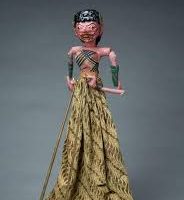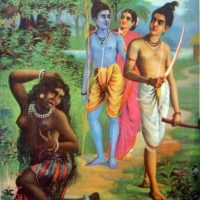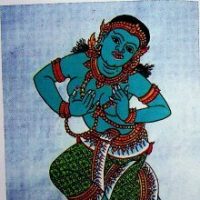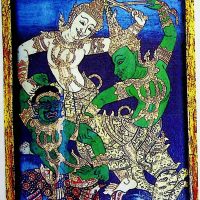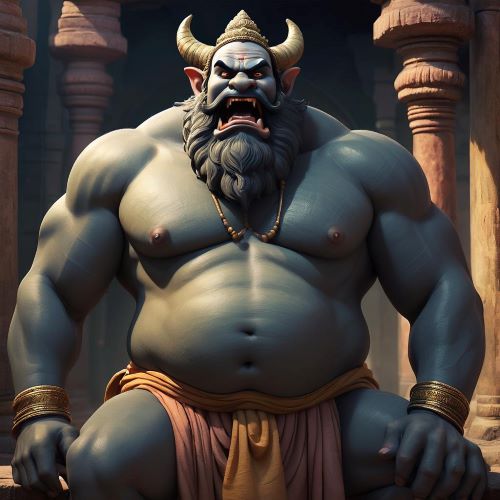Shurpanakha : The Jilted Rakshasi
Listen
At a glance
| Description | |
|---|---|
| Origin | Asian Mythology |
| Classification | Mortals |
| Family Members | Vishrava (Father), Kaikesi (Mother), Ravana, Kumbhakarna, Vibhishana (Brothers) |
| Region | India, Sri Lanka, Thailand, Indonesia |
| Associated With | Difigurement |
Shurpanakha
Introduction
Shurpanakha (Sanskrit: शूर्पणखा), whose name translates to “she whose nails are like winnowing fans,” is one of the most intriguing and misunderstood characters in the Indian epic Ramayana. As the sister of Ravana, the mighty king of Lanka, her actions serve as the catalyst for one of mythology’s greatest wars. Traditionally depicted as a rakshasi or demoness, Shurpanakha’s encounter with Rama and Lakshmana sets off a sequence of events that ultimately leads to Sita’s abduction and the climactic battle of Lanka. However, across South and Southeast Asia in Sri Lanka, Thailand, Indonesia, and beyond, her character takes on varied shades of emotion and symbolism. Sometimes villainous, sometimes tragic, Shurpanakha stands as a powerful reminder of passion, rejection, and the complex dynamics of femininity and power.
Physical Traits
In Valmiki’s Ramayana, Shurpanakha is portrayed as grotesque and fearsome, her appearance embodying the archetypal qualities of a rakshasi. She is described as pot-bellied, copper-haired, cross-eyed, and brassy-voiced, with her most distinctive feature being her long, claw-like fingernails. These nails likened to winnowing fans earned her the name Shurpanakha. This physical form symbolizes inner chaos and desire unchecked by restraint.
Yet, regional retellings soften her image. In the Kamba Ramayanam of Tamil literature, Shurpanakha is described as beautiful and lovelorn, her behavior stemming not from malice but from loneliness and rejection. Here, she is known as Meenakshi, “the fish-eyed one,” suggesting large, expressive eyes and emotional depth. Thai mythology’s Ramakien depicts her as Samanakkha, with a green complexion and alluring yet exaggerated features, while Javanese and Balinese adaptations present her as Sarpakenaka, stylized in puppetry with angular limbs and dramatic masks. These varying depictions reveal how Shurpanakha’s image evolved from monstrous to tragically human, depending on the cultural lens through which she is viewed.
Family
Shurpanakha was born into the powerful and complex family of sage Vishrava and the rakshasi Kaikesi. This dual heritage gave her both divine wisdom and demonic temperament. Her brothers Ravana, Kumbhakarna, and Vibhishana represent different facets of power, indulgence, and virtue. Ravana, her eldest brother, adored her yet caused her immense pain when he killed her husband, Vidyutjihva, a Danava prince she had married for love. This act of fratricidal cruelty left Shurpanakha widowed and embittered, further isolating her from her family.
She later took refuge in the Dandaka forest, where her brothers Khara and Dushana ruled. It was here that she encountered Rama, Sita, and Lakshmana in an event that changed the course of her life and the destiny of the Ramayana itself. Some lesser-known versions mention that she bore a son, Shambhri, whose death added to her grief, deepening her portrayal as a woman driven not by evil but by heartbreak and revenge.
Other names
Shurpanakha’s identity is layered with multiple names across traditions. Her birth name, Meenakshi, emphasizes beauty and grace, contrasting sharply with her later demonic portrayal. She is also known as Chandranakha, meaning “one whose nails are like the moon,” which may reflect both her physical traits and her volatile temperament. In the Ramakien of Thailand, she appears as Samanakkha, while in Javanese and Balinese versions, she becomes Sarpakenaka. These alternate names capture the diversity of her mythic evolution from alluring woman to vengeful demoness and highlight how oral traditions transformed her to suit local narratives and moral lessons.
Powers and Abilities
As a rakshasi, Shurpanakha possessed formidable supernatural powers. She could change her form at will, a gift she used to appear as a beautiful woman when she approached Rama in the forest. Her ability to fly, create illusions, and summon lesser demons made her a powerful figure among the rakshasas. In some regional adaptations, she is portrayed as a skilled enchantress, capable of manipulating minds and emotions, while others depict her as a symbol of destructive passion and misdirected desire.
Despite her mystical gifts, Shurpanakha’s strength lay as much in her defiance as in her powers. She dared to express desire openly, defied familial authority, and confronted humiliation without submission. In that sense, she represents a powerful yet tragic archetype of suppressed womanhood, one punished not merely for her actions but for her audacity to transgress social and divine boundaries.
Modern Day Influence
In modern culture, Shurpanakha’s legacy continues to evolve. Indian television adaptations, such as Ramayan (1987), Siya Ke Ram, and various animated retellings, have reintroduced her as a pivotal figure whose rejection by Rama triggers the larger conflict. Yet, in contemporary interpretations, her story is increasingly seen through a feminist lens. Writers and scholars reinterpret her disfigurement not as divine justice but as a symbol of gendered violence, an act meant to silence a woman who dared to speak and desire freely.
In Sri Lankan traditions, she is sometimes reimagined as a misunderstood woman whose emotional needs were ignored by both her family and fate. In Thailand’s Ramakien, Samanakkha is portrayed in dance dramas (Khon) with a blend of humor and tragedy, her exaggerated gestures symbolizing vanity, longing, and heartbreak. Indonesian shadow puppet theater (Wayang Kulit) continues to feature her as a lesson in moral duality reminding audiences that desire and discipline must coexist for harmony to prevail.
Beyond performance arts, Shurpanakha has become a potent cultural metaphor. In literature and academic discussions, she represents the stigmatized woman, ridiculed, violated, and erased from heroic narratives. Modern reinterpretations in novels, plays, and essays often reclaim her voice, portraying her as a figure of resistance and emotional authenticity. Her story has even inspired discussions in gender studies, exploring how mythological women mirror societal attitudes toward power, sexuality, and independence.
Related Images
Source
Valmiki. (ca. 5th century BCE). Ramayana: Aranya Kandha. Retrieved from https://en.wikipedia.org/wiki/Shurpanakha
Raja Gopalachari, C. (1957). Ramayana: A condensed prose version of the epic. Bhavan’s Book University.
Dirghangi, A., & Mohanty, S. (2019). De-mythifying the Ramayana: A Study of Surpanakha. Proceedings of the 6th International Conference on Arts and Humanities, Vol. 6, pp. 8-15. Retrieved from https://proceedings.tiikmpublishing.com/data/conferences/doi/icoah/23572744.2019.6102.pdf
Rajshekhar Basu. (1980). Uttarkanda, Valmiki Ramayan.
Surpanakha – Dreadful Demoness or Wronged Damsel? (2020, March 16). Dolls of India. Retrieved from https://www.dollsofindia.com/library/surpanakha/
Four The Mutilation of Surpanakha. (n.d.). University of California Press. Retrieved from https://publishing.cdlib.org/ucpressebooks/view?docId=ft3j49n8h7&chunk.id=d0e4061&toc.id=d0e4061&brand=ucpress
VoVatia. (2019, September 3). Surpanakha. Retrieved from https://vovatia.wordpress.com/tag/surpanakha/
The Ramayana Tradition in Asia (n.d.). Archive.org. Retrieved from https://ia600609.us.archive.org/17/items/in.ernet.dli.2015.213572/2015.213572.The-Ramayan_text.pdf
Frequently Asked Questions
What is lorem Ipsum?
I am text block. Click edit button to change this text. Lorem ipsum dolor sit amet, consectetur adipiscing elit. Ut elit tellus, luctus nec ullamcorper mattis, pulvinar dapibus leo.
What is lorem Ipsum?
I am text block. Click edit button to change this text. Lorem ipsum dolor sit amet, consectetur adipiscing elit. Ut elit tellus, luctus nec ullamcorper mattis, pulvinar dapibus leo.
What is lorem Ipsum?
I am text block. Click edit button to change this text. Lorem ipsum dolor sit amet, consectetur adipiscing elit. Ut elit tellus, luctus nec ullamcorper mattis, pulvinar dapibus leo.
What is lorem Ipsum?
I am text block. Click edit button to change this text. Lorem ipsum dolor sit amet, consectetur adipiscing elit. Ut elit tellus, luctus nec ullamcorper mattis, pulvinar dapibus leo.
What is lorem Ipsum?
I am text block. Click edit button to change this text. Lorem ipsum dolor sit amet, consectetur adipiscing elit. Ut elit tellus, luctus nec ullamcorper mattis, pulvinar dapibus leo.


